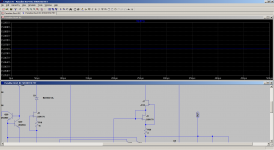What kind of glue will be good for this purpose?
i thought of those softer mats with two adhesive sides similar to: BERGQUIST - BG405793, just that i have a hard time finding something with two adhesive sides.
norway is a third world country when i comes to electronics distributors
So is Denmark, or though we just got Conrad.DK but at 10 times the prices of Conrad.DE unfortunatlynorway is a third world country when i comes to electronics distributors
Plastic body of transistor stick vell with super glue cooper house around them also help but increase thermal impedance (time temparature take to setle)
point was raised by Salas a long while ago and also by me with implementation of larger heat sinks and reduced voltagge to suply.
Maybe new boards to alowd for current sources pairs to be glued togheter is one thing to consider
point was raised by Salas a long while ago and also by me with implementation of larger heat sinks and reduced voltagge to suply.
Maybe new boards to alowd for current sources pairs to be glued togheter is one thing to consider
Thermal Pad 120 x 20 x 1 mm 2 Sides Adhesive for RAM Notebook Consoles VGA VRM | eBay
This seems to be a lot cheaper than Mouser
This seems to be a lot cheaper than Mouser
He was just trying... Nevertheless, that points towards an interesting insight, that simply by isolating from air movement the drift reduces significantly. Have to try this at home....
great job heinz! let us know your listening experience...
I was expecting that, but just wanted to verify it. The point was brought up before, some while ago I did suggest (for testing) to place a little box (like a match box was suggested) over the transistors and then see what happens. Anyway, if it works (or not), one must take precautions not to isolate the transistors from the environment, they may/will get to hot! (just wanted to make this point
OK! Got the babys here on spot now.
Checked the servo output again. -It is not 18V; it is +15,57V!
The voltages at R5 are -0,575V and +0,615V.
(At the "good channel they are -0,62 and + 0,563V.)
Then somethign else is wrong. Can you please check the voltage on both ends of R5? Should be +/- 0.6V
Checked the servo output again. -It is not 18V; it is +15,57V!
The voltages at R5 are -0,575V and +0,615V.
(At the "good channel they are -0,62 and + 0,563V.)
OK! Got the babys here on spot now.
Checked the servo output again. -It is not 18V; it is +15,57V!
The voltages at R5 are -0,575V and +0,615V.
(At the "good channel they are -0,62 and + 0,563V.)
The voltages at R5 look OK, considering the servo output voltage. I would imagine the output voltage of the amplifier is negative, correct? (Sorry I forgot). Could you please measure the voltage at the "Ext RIAA" connector?
Sorry!
Great Confusion!
Output Voltage is +15,57V and RIAA is 15,8V.
Servo Voltage (Pin6 OPA) is -18Volt!
hi Gandralf, something is going VERY wrong here. Looks like the servo is doing his job, though, and the problem is somewhere else. I suspect the current mirror around Q6-Q9, you may want to check if all those transistors are correct and working. The voltages on test points TP9 and TP10 should be as indicated in the assembly guide (-16.5V); if they are stuck at -18V then no current is flowing in that mirror.
Let me know if you can find the problem, alternatively send the boards to me (but within this week, please - have to travel end of next week.....)
yes, it could be the output buffer. according to these values, the current mirror is biased correctly. Something is pulling down the voltage at the connection of the mirrors.
Is there a voltage difference between "Ext RIAA" and the output?
... oops, just saw you already posted that value - yes it looks like Q99 has a problem.....
Is there a voltage difference between "Ext RIAA" and the output?
... oops, just saw you already posted that value - yes it looks like Q99 has a problem.....
yes, it could be the output buffer. according to these values, the current mirror is biased correctly. Something is pulling down the voltage at the connection of the mirrors.
Is there a voltage difference between "Ext RIAA" and the output?
... oops, just saw you already posted that value - yes it looks like Q99 has a problem.....
Or Q90.
As mentioned earlier, i have tried my paradise, and the sound is amazing, but the gain is lower than the rest of my components ( I have to bottom my volumepot out to get a realistic listening level) So i just wonder if it is suppose to be like that, or if i maybe have made a blooper somewhere?
As mentioned earlier, i have tried my paradise, and the sound is amazing, but the gain is lower than the rest of my components ( I have to bottom my volumepot out to get a realistic listening level) So i just wonder if it is suppose to be like that, or if i maybe have made a blooper somewhere?
that is a little surprising. I found it to operate on par with other phono stages and no big difference in gain (I seem to remember 60-65dB at 1kHz). If the tonality is correct (in other words, excluding any issue with the RIAA section), the gain should be more than enough, even with the lowish output voltage of your cartridge.... strange....
do you have the means to measure the gain, e.g. with a 1V sinewave input @ 1kHz, and a 1000:1 voltage divider (10kOhm : 10 Ohm) at the input, then the output voltage should again be 1V (since 1000:1 == 60dB)?
- Home
- Source & Line
- Analogue Source
- Paradise Builders
